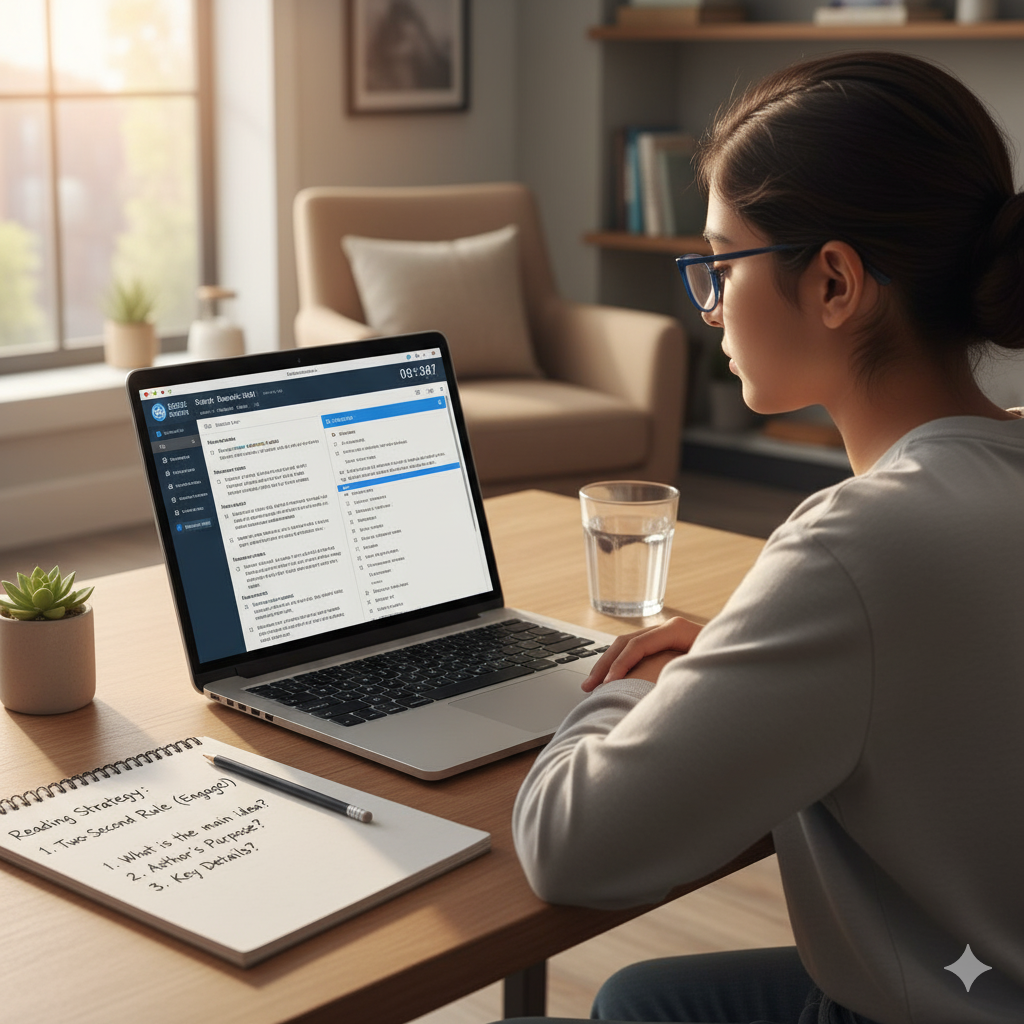Introduction: The Strange Case of the Missed Easy Question
Ever felt that tiny jolt in your stomach when you look back at a practice SAT section and find that the question you got wrong was one you thought you could answer with your eyes closed? You read the topic, you relaxed, and then—boom—your confidence betrayed you. It’s a familiar plot twist for thousands of students prepping for the Digital SAT.
This blog isn’t here to scold you. Instead, we’ll walk through the real reasons students overlook questions on familiar topics, offer specific fixes you can use in practice and on test day, and show how a tailored approach (including targeted 1-on-1 help like Sparkl’s personalized tutoring) can turn those near-misses into steady score improvements.
Why Familiarity Breeds Carelessness: The Psychology Behind the Error
1. The Comfort Gap: When Confidence Outruns Care
When you see a topic you think you know—say quadratic equations in the Math section or subject-verb agreement in Reading & Writing—your brain signals “routine” instead of “vigilant.” That shortcut saves cognitive energy, but it also reduces the attention you give to details like subtle qualifiers, tricky wording, or incomplete answer choices. The result: you answer quickly, and sometimes, incorrectly.
2. Pattern Overfitting: You Expect One Right Template
Students often learn a template for solving a type of problem. Templates are powerful tools, but they can be rigid. If a Digital SAT question twists the standard pattern—by changing a variable, inserting an embedded clause, or asking for a different interpretation—students who default to the template may miss the twist entirely.
3. Familiarity Fatigue: Mental Laziness After Repetition
Hours of practice on the same topic can dull your attention. Repetition is essential, but without variation, you might train yourself to skim instead of analyze. On long test days, familiar topics become danger zones for mind-wandering.
4. Overconfidence and Self-Fulfilling Mistakes
Overconfidence leads to fewer checks. If you assume you’re right, you might skip re-checking arithmetic, failing to spot small mistakes that add up in a score-sensitive test.
5. The Digital Interface Effect
The shift to the Digital SAT brings interface differences—on-screen navigation, highlighting tools, passages presented in new ways, and adaptive sectioning. Students who are comfortable with a topic on paper might stumble when their usual workflow is interrupted by the digital format.
Real-World Examples: How a Familiar Topic Trips You Up
Let’s turn the abstract into the concrete. Here are three short examples that mirror real SAT traps:
- Math (Algebra): You recognize a linear equation, plug in what you usually do, and solve for x—but you didn’t notice the phrase “for all integer values” that restricts the solution set. The right answer requires an integer-only check you skipped.
- Reading: You see a passage about climate and jump to pick the main idea you always associate with climate passages, ignoring a paragraph that narrows the author’s focus to policy implications.
- Writing & Language: A sentence seems fine at first glance, but the answer hinges on a comma splice you glossed over because the grammar rule felt routine.
How to Stop Overlooking Familiar Questions: Practical Strategies
Fixing the problem requires both mindset shifts and concrete habits. Below are targeted strategies you can practice right now.
Strategy 1: Force a Micro-Delay (The Two-Second Rule)
Before answering any question on a “familiar” topic, pause for two seconds and re-state the question in your head. What exactly is being asked? Re-phrasing forces your brain out of autopilot and into active problem framing.
Strategy 2: Ask Three Quick Diagnostic Questions
Make these a routine checklist for every problem you feel confident about:
- What is the question actually asking?
- What assumptions am I making?
- Does the context change the usual approach?
These quick diagnostics expose hidden qualifiers and help prevent template overfitting.
Strategy 3: Make the Familiar Slightly Unfamiliar
When practicing, actively change variables or swap answer formats. If you’re doing algebra, practice the same skill with decimals, fractions, word problems, and purely symbolic forms. If the Reading topic is familiar, practice with passages that shift tone or structure so your brain learns to re-evaluate instead of repeat.
Strategy 4: Use the Digital Tools—But Don’t Rely on Them Blindly
The Bluebook testing app offers highlighting, flagging, and answer review. Use highlighting to mark qualifiers; flag questions that you answered quickly so you can return with fresh energy. But don’t let digital conveniences replace the mental checks above.
Strategy 5: Create a Mistake Log Focused on Familiar Topics
Not all mistakes are equal. When you miss a question on a familiar subject, record:
- The question type (e.g., linear equation, passage inference)
- Why you missed it (e.g., misread qualifier, rushed algebra step)
- A short corrective habit (e.g., always check parity, always underline the phrase)
Over time, patterns emerge—and the patterns are where big score gains hide.
Time Management Tactics to Protect Focus
Running out of time increases the temptation to answer quickly on familiar topics. Here are tactics to preserve focus under time pressure.
Smart Pacing: The 60/30 Rule
On a timed section, try this pacing framework: spend up to 60% of your allotted time on the problems that feel unfamiliar or are clearly high-value. Use the remaining 40% for questions you recognize quickly, but reserve a minimum re-check window at the end. The idea is to avoid burning all your time on the challenging items and then rushing the ‘easy’ ones.
Flag Early, Return Later
If a familiar question looks deceptively simple, flag it and move on. Return to flagged items during a scheduled review phase. Some students find that returning with more focus uncovers the small traps they missed earlier.
Short Breaks During Practice
When doing long practice blocks, insert brief breaks (2–5 minutes) every 30–40 minutes. Familiarity fatigue is real—micro-breaks help maintain attention for the long haul.
Practical Exercises You Can Do This Week
Use the following exercises to turn the strategies above into muscle memory. Try doing them three times this week and record your results.
- Targeted Variation: Take five algebra problems of the same type and rewrite each one to include a small twist (decimals, odd constraints, extraneous information). Work through them calmly and note where the twist would have caused a careless mistake.
- Two-Second Pause Drill: In a reading block, force a two-second rephrase before every question. Track how many fewer careless mistakes you make when you rephrase vs. when you don’t.
- Mistake Log Review: After a 50-question practice, list your mistakes and tag those on familiar topics. Add one corrective action for each and practice only those corrective actions for the next 30 minutes.
Table: Quick Checklist to Prevent Overlooking Familiar Questions
| Step | Action | Why It Works | Time Cost |
|---|---|---|---|
| 1 | Two-Second Rephrase | Forces active framing; prevents autopilot answers | ~2 seconds |
| 2 | Ask the 3 Diagnostic Questions | Exposes hidden qualifiers and assumptions | ~5–8 seconds |
| 3 | Flag & Move On | Protects pacing; reduces rushed errors | ~3 seconds |
| 4 | Final Re-check (for flagged) | Catches small mistakes after mental reset | Varies (2–90 seconds) |
How Practice Should Change When You Know a Topic Well
Most students practice until they reach comfort and then keep repeating the same problems. Instead, use an S-curve practice model:
- Stage 1 — Build: Learn the core method until you can solve the base problem.
- Stage 2 — Stretch: Intentionally change problem conditions so the method must adapt.
- Stage 3 — Solidify: Mix base problems with stretched versions, under timed conditions and with review logs.
This approach keeps your brain engaged and prevents the complacency that leads to overlooked questions.
Technology and the Digital SAT: Adapting Familiar Habits
Preparing for the Digital SAT means matching your problem-solving habits with the platform. If you usually underline on paper, learn to use the highlighting tool in the testing app. If you rely on margin notes, practice typing short virtual notes or using the app’s flagging and comment features—whatever is available to you.
Familiarity with the topic must be matched with familiarity with the interface. Practice on the same device you’ll use on test day and simulate test conditions so that cognitive load from the digital environment doesn’t distract you from the content itself.
How Personalized Tutoring Helps Turn Familiarity into Reliability
General tips are great, but turning a specific weakness into a strength often requires tailored guidance. That’s where focused, personalized tutoring comes in. A smart tutor can:
- Diagnose the exact point where familiarity fails—e.g., a repeated misreading of qualifiers or a tendency to skip parity checks in algebra.
- Create micro-lessons to isolate the error and automate a corrective habit.
- Provide timely feedback during practice blocks and simulate test-day digital interface constraints.
If you’re interested in 1-on-1 guidance, Sparkl offers personalized tutoring plans with tailored study schedules, expert tutors, and AI-driven insights to pinpoint patterns in your mistakes. When used alongside deliberate practice, this kind of support helps you convert the comfort of familiarity into consistent, reliable performance.
What Tutors Look For That Students Often Miss
Experienced tutors focus less on teaching new content and more on:
- Micro-behaviors (how you read a sentence, where your eyes land on a diagram)
- Decision thresholds (when you choose to guess vs. work out a problem)
- Recurring mental shortcuts and why they break down
By addressing these small, specific habits, tutors help students close gaps that practice alone might not fix.
Checklist: What to Do the Day Before and the Morning Of
Keeping your mental state steady reduces the chance of careless errors on familiar topics.
- Day Before: Do a short, mixed practice block (30–40 minutes). Review mistakes and add any familiar-topic misses to your log. Get a good night’s sleep.
- Morning Of: Do a 10–15 minute light warm-up focused on micro-checks (two-second pause, diagnostics). Eat a balanced breakfast and avoid cramming.
- On Test Day: Use the two-second rule for every question. Flag quick answers and return during review time. Use the digital tools (highlighting/flagging) to mirror your practice habits.
Putting It All Together: A Weekly Plan to Stop Overlooking Familiar Questions
Here’s a sample week you can use to convert these ideas into habits. The goal: make careful analysis automatic for familiar topics.
- Monday — Focused Practice (60 minutes): Pick one familiar topic. Do 20 mixed problems with deliberate twists. Keep a mistake log.
- Tuesday — Variation Drill (45 minutes): Rewrite familiar problems to include constraints or unusual formats. Time yourself on each.
- Wednesday — Timed Mix (75 minutes): Full timed section. Apply two-second pause and diagnostic questions. Flag quick answers and review.
- Thursday — Tutor Review / Self-Review (30–60 minutes): Work with a tutor or review your mistake log. Create corrective micro-habits.
- Friday — Interface Practice (30 minutes): Practice on your test device. Use Bluebook-like tools, highlight, and type quick notes to simulate test conditions.
- Weekend — Full Practice Test (3–4 hours): Simulate test day, including breaks. Review every familiar-topic mistake and add the corrective habit to your log.
Final Thoughts: Turn Familiarity into an Asset, Not a Trap
Missing a question on a topic you know is frustrating, but it’s also an opportunity. Those mistakes are high-leverage: they’re usually small, fixable habits rather than deep content gaps. With a few strategic rituals—the two-second rephrase, the three diagnostics, purposeful variation, and the right pacing—you can reduce careless errors dramatically.
If you want a boost, personalized tutoring that focuses on your mistake patterns can accelerate progress. Sparkl’s 1-on-1 guidance, tailored study plans, expert tutors, and AI-driven insights are built to identify those recurring traps and design micro-practices that stick. When you pair that support with deliberate practice, familiar topics stop being hazards and start being reliable score-winners.
Remember
Comfort is a double-edged sword in test prep: it speeds decisions but can steal accuracy. Train your brain to treat comfort as a cue to check—not to coast—and you’ll find that the easy questions stay easy, the familiar ones become fail-safe, and your scores begin to reflect your true abilities.
Ready to practice differently?
Start small: today, on one practice question you think you know, try the two-second rephrase and the three diagnostics. See what you discover. Those tiny moments of extra attention add up faster than you think.
















No Comments
Leave a comment Cancel